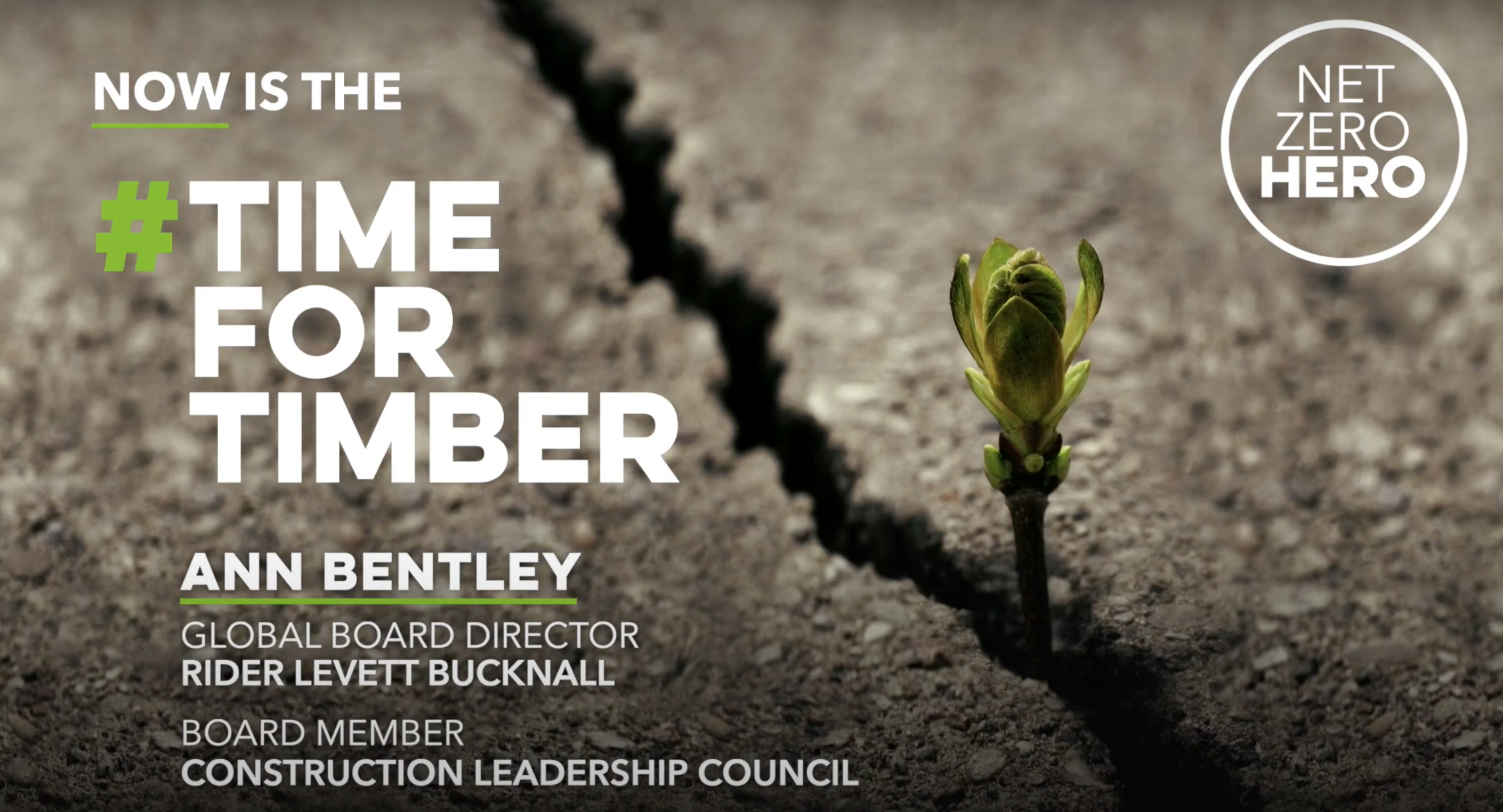Ann Bentley is Global Board Director at Rider Levett Bucknall, a leading independent organisation in cost management and quantity surveying, project management and advisory services. Her role is providing advice to the RLB UK Board on governance, global matters and government level thinking on issues affecting the business and the wider industry, now and in the future.
She is also a Board Member of The Construction Leadership Council.
Here is her thinking as to why now is the time for timber.
Is the UK construction industry ready for climate change and carbon reduction?
I think it’s very mixed if I’m honest. What I have found in the work that I have done in procurement, is not only an industry fragmented in terms of lots of different suppliers, but it’s also multi-layered. You have the top 20 or 30 companies, whether that’s the contractors or the consultants, who are very well prepared. They understand it, they understand the technology, they understand their supply chains. But when you get down to Level 2, let alone Levels 3,4,5 and six, frankly they are just looking to the next job and here there is very little preparedness.
How can we ensure net zero features strongly in procurement moving forward?
The work that I’m doing is all about balance and it is trying to bring to the attention of clients all the things that they need to balance when they’re looking at construction projects. What we have found through research is that it’s not a lack of desire, it’s actually a lack of knowledge from clients. We think there’s two things that need to be done; we think that the sort of statute needs to be very, very crystal clear because what most clients do is abide by the law. Secondly we also feel that the information that clients have available to them and the way that they can make value based decisions needs to be easier, that they can see the data, that they have clear information, that they have really, really clear figures in terms of, not just the building project but what it is that they are building and how that will operate in use over 5, 10, 20 or even 100 years.
How does the Construction Leadership Council promote and support net zero?
The Construction Leadership Council (CLC) has recently published its climate statement and it is very, very supportive of net zero. The CLC is made up of both government and industry members and the government has put legal commitments to net zero. I think everybody who sits around the CLC table realises that, essentially it’s not about 2050, it’s about today because every single building that we build in the next few years we hope will still be standing in 2050. So this isn’t a future thing, this is a very current thing. It’s fair to say that Coronaviruses has rather overtaken the CLC in the last six months, but net zero is right up there on the agenda and I think you will see much more of that in the next six months.
What is your view on the use of certain sustainable products in a risk averse market for insurers and lenders?
I think there are some examples from history and in other areas. We are having exactly the same issue with a professional indemnity insurance on cladding of high-rise residential buildings at the moment, irrespective of what the material is. You’ll find architects, in particular, who specialise in high rise buildings. Their professional indemnity insurance premiums have doubled or even trebled over the last three years. That means that you are seeing people stepping away from certain markets completely. I don’t mean the insurers, I mean the consultants and the contractors. What you are finding is that it is becoming increasingly difficult to even commission a high rise building because we don’t want to pay the insurance, as designers. So I think that there will be a bit of market re-levelling because if you get clients who want to build things, but designers refuse to design them because they can’t carry the liability, something has to give eventually. I think we will see a greater movement to things like whole project insurance, where you will get a combination of not just the professional indemnity you will also get the building indemnity. You might even get some building performance, you might get construction performances – all sorts of packages that can go into whole project insurance. This has been kicking around now for probably 20 years and there’s not that many people that are advocating it because ultimately it brings the cost of insurance down. It is a personal view of mine, but the insurers probably aren’t too keen on it as individual practitioners have to group together. I think we are going to see a massive shake up because something is going to have to give and maybe one of the areas it will give first is in public procurement. If you’re the Ministry of Defence you have probably less of an interest in some of these problems than a big developer, or a big property holder. I see that the government has a huge role to play in this, because if they can build portfolios of schools, or MoD accommodation, or prisons, or whatever and it is shown to be robust and environmentally sustainable and has high social value then others will follow. I think there will be commercial pressure on this and I think there will be governmental pressure as well.
What role do Modern Methods of Construction (MMC) have to play moving forward?
It’s probably driven by the housing crisis but actually this is only one of the constituent parts. Last year the government made what I think is a really significant announcement. Five key government departments have now been instructed that when they commission construction work, they have to have what is called a ‘presumption of favour of MMC’. It doesn’t mean they actually have to use modern methods of construction, it means that they have to first look at modern methods of construction and they then have to put forward definitive argument as to why they can’t use it. It is a sort of opt out, rather than an opt in. What we have seen is that some departments are much keener on this than others and to be fair, the Department for Education is very keen. It sees significant standardisation in MMC. It builds in the region of 200 new schools a year. Some of the push back that is often given to MMC is ‘Oh well everything looks the same and it’s all really boring.’ I don’t believe that, but even if it were true, you never build two schools next to each other, so this becomes completely irrelevant. So certainly the Department for Education are very keen to progress it, the Ministry of Justice are quite keen to progress it and so we are seeing a trickle down from central government to the departments and then from the departments to the suppliers. I think that over the next two or three years we will see really significant growth in MMC. The government is also funding the MMC development programme at the construction innovation hub. That has got considerable funding from the transforming construction challenge fund behind it, very much looking at what they call a ‘platform approach’. This is asking how can we get standardised modules, so that we can almost have a catalogue and that government departments can sort of ‘Lego’ it? A little bit of an over simplification, I agree, but that’s almost the terminology they are using. You have 10,000 component parts that could be made by a million suppliers and then you can build your building from those 10,000. We have seen the initial acceleration and it is definitely growing by the day and, had it not been for the Coronavirus, I think we would have seen it a lot sooner.
Do you see timber use in MMC being prolific in the future?
There are different schools of thought on this and some of the advocates of the ‘platform approach’ aren’t particularly talking about timber, but and it’s a huge but, we still have to look at the embodied carbon. If you’re using steel-framed MMC, or indeed precast concrete planks, which is still MMC, then we are forgetting about embodied carbon. So from a Rider Levett Bucknall (RLB) perspective, if we’re looking at the holistic project, if we’re looking not just at how you build it but how you use it and how you might even take it down, then clearly timber has a massive role to play in this.
With France setting a target for public buildings to be built using 50% timber, can you see something similar happening in the UK?
As a business RLB has offices throughout Europe and so we see many different construction techniques and many different procurement systems. What has struck me for a long time is that the northern European, particularly the Nordic countries, have been using timber since time immemorial and I would say well over 50 per cent of their buildings are already based on timber, so the French government setting a target for 50% is clearly achievable in terms of using timber as the primary construction material. To be fair to the UK, I think that although we might have set targets differently, our targets are in terms of MMC and the presumption in favour, I’m pretty sure that the UK government is expecting something in the order of 80% of public procurement to end up as a modern methods of construction of some sort and so timber must be up there. I think that we will have similar targets in the UK.




